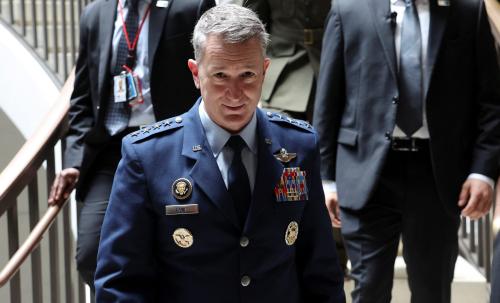It is somewhat oxymoronic to talk of defense budget cuts as the United States also continues to be part of two wars while simultaneously trying to stimulate the economy. But these are oxymoronic times and so it is sensible, even necessary, to do so.
Two major deficit reduction commissions are underway, with results to be presented after the midterm elections. What should they recommend about how to deal with the more than $700 billion annual defense budget – still at least four times that of China’s, still more than 40 percent of total global military spending, and still large even measured against the size of our economy and our government?
This essay doesn’t take a strong stand on the right approach; frankly I am still trying to figure out my own mind. But it is useful to identify four basic frameworks or paradigms for having the Department of Defense (and associated intelligence and contractor activities) make at least some contribution to fiscal restraint. Only if we have a common commitment and a sense of shared sacrifice across all parts of government and society are we likely to cut our nearly $1 trillion annual structural deficit roughly in half – which is roughly what’s needed to restore sound fundamentals to our nation’s economic health.
Before discussing numbers, a word on baselines: today’s yearly defense budget can be viewed as including some $550 billion for normal, “peacetime” or basic defense costs and nearly $200 billion more for Iraq and Afghanistan. The former number naturally grows at about 2 to 3 percent a year in real terms since almost everything the Pentagon does – from maintaining aging and complex equipment to compensating our committed and capable troops to buying new weapons to providing health care – grows in cost faster than inflation. So taking 2014 as a focus year for analysis, we might think of that year’s base budget as $100 billion more than today’s, or $650 billion, with roughly half the increase due to inflation itself and the other half due to these growing core expenses. The yearly total would then be about $850 billion if overseas military operations continued at their current pace. With that in mind, consider:
- “Peace is the Dividend.” (Annual savings of about $150 billion once the wars are at least mostly over.) Paraphrasing former Vice President Cheney, when he made that comment as defense secretary two decades ago, one might say that the Department of Defense is already on track to save us lots of money just by ending the wars and our military commitments in Iraq and Afghanistan. If for example we got down to 10,000 troops in Iraq and 25,000 in Afghanistan by 2013/2014 (about what I’d expect and recommend, even if it’s not necessarily current policy per se), these might be the savings. The base defense budget would have grown in the meantime of course, above and beyond inflation, so the total 2014 defense budget would then be about $700 billion a year – meaning slightly less than today’s in nominal dollars and considerably less in inflation-adjusted dollars. That is no small reduction, even if it is also an expected one.
- “Continuation of the Gates Reforms.” (Estimated annual savings about $10 billion.) In April 2009, Secretary Gates ceased further production of the F-22 fighter, curbed two programs within missile defense, stopped a major ship program, and canceled the Army’s Future Combat System vehicle modernization effort. Now he wants to close Joint Forces Command and streamline the number of generals and admirals in the military – and also reduce contractors by 30 percent. This latter projection strikes me as arbitrary as well as a bit abstract, if not necessarily wrong; alas arbitrary and abstract defense reduction proposals tend not to happen based on past experience. So I would not assess this projected reform as saving nearly as much money as might be hoped. But the more specific ones Mr. Gates has proposed seem reasonable and doable.
- “Stop Overinsuring on Weapons Acquisition.” (Annual savings about $20 billion.) Despite Gates’s efforts, we still buy lots and lots of extra insurance within our armed forces. This is partly out of a desire to stay way ahead of China even as it modernizes fast and as we remain committed to the security of Taiwan. Concerns about improved antiship and antiaircraft and land-attack missiles, as well as other potent technologies our adversaries could employ (cyberweapons, anti-satellite weapons), drive much of this agenda too.
Contrary to popular belief, few if any of our weapons today are being bought just because they are Cold War leftovers that the Pentagon refuses to kill. That said, we arguably do over insure. In an era of remarkably effective drones, and extremely accurate munitions as well as powerful sensor and information systems to guide them to target, we still plan to buy 2500 F-35 manned aircraft. In an era when stealthy and fast coastal-water ships like the Stiletto are available we still turn our littoral combat ship into what is essentially a small frigate. Other examples exist as well. This is not a prescription for slashing weapons modernization budgets, or ignoring the need to stabilize and sustain the American national security industrial base, which is under some duress already. But it is a way to cap and stabilize modernization budgets near current levels rather than see them grow a good deal more in coming years in what would probably be the start of yet another feast-or-famine cycle for the defense industry.
- “Rethink the Holy Grail of Personnel Costs.” (Annual savings perhaps $15 billion.) No one wants to talk about cutting or even capping military pay at a time of war, and that includes me. But there are ways to nonetheless reconsider whether we need to spend an average of well over $100,000 a year in total compensation costs for every person in uniform in our country today.
Beyond Gates’ ideas of cutting back on generals and admirals, I would consider curbing their somewhat too generous pensions. We might again reconsider rethinking the military retirement system to modify the 20-or-nothing pension system (whereby one gets a generous pension after 20 years of service but nothing before). The “TRICARE for life” no-cost changes of the late 1990s that gave greater benefits to current retirees were arguably too generous and not relevant to the current force and could be revoked or at least redefined less generously.
Most radically, we might even consider rethinking whether we need today’s rank structure. At a time when young officers and NCOs in the field make such key decisions, at a time when warfare has advanced so much and spread decision-making across all ranks, might it be time to consider say simply eliminating a rank – say the rank of major? This is obviously easier said than done, but if we want to reduce our need for officers, this kind of reform would do a lot more than clipping our general-officer ranks.
It is too soon to make decisions on these issues, perhaps, but not too soon to start considering them. We need a very strong military but there is no reason to think our armed forces are currently organized and staffed, or our weapons purchased and maintained, in the most efficient possible ways.
The Brookings Institution is committed to quality, independence, and impact.
We are supported by a diverse array of funders. In line with our values and policies, each Brookings publication represents the sole views of its author(s).



Commentary
Op-edDefense Cut Proposals Deserve Thought
September 3, 2010